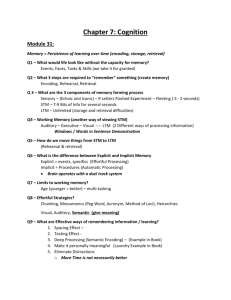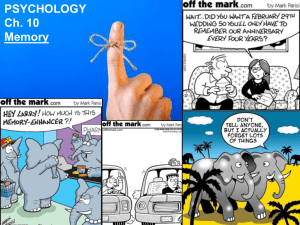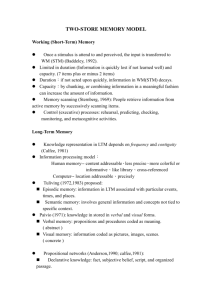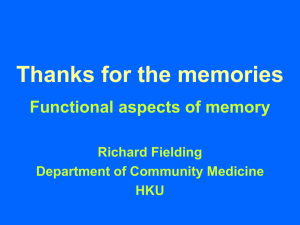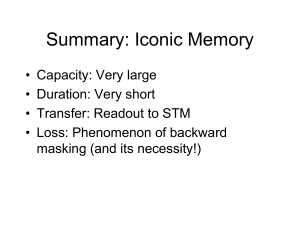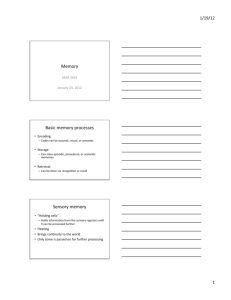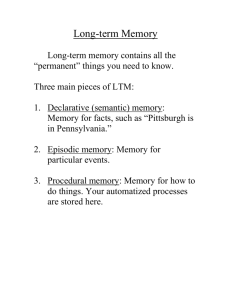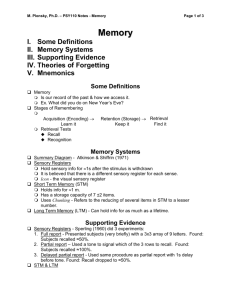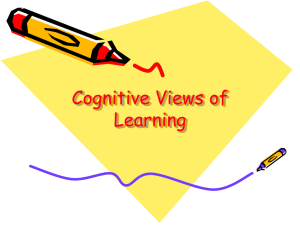Ch-28-+-29-Localisation-of-Memory-+
advertisement
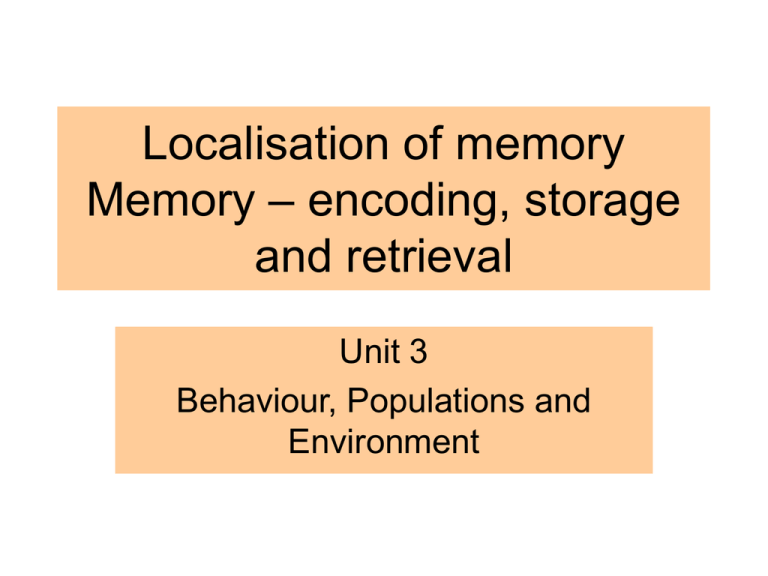
Localisation of memory Memory – encoding, storage and retrieval Unit 3 Behaviour, Populations and Environment Learning Outcomes • To learn about the limbic system in relation to memory storage • To examine the process of memory – encoding, storage and retrieval • To compare the differences between long and short-term memory and how memory is transferred from STM to LTM • To find out what causes Alzheimer’s disease at a molecular level Limbic System Declarative and Procedural memories Declarative Procedural • Cerebellum • Temporal lobes • Limbic system Motor skills e.g. knowing how to swim Recall of general facts e.g. identifying familiar objects Mental skills Recall of personal facts e.g. past experiences e.g. knowing how to read a book Neuronal level • Most procedural skills are not easily forgotten • Many declarative memories are retained on long-tern or permanent basis • Thus, memory is the result of a long-term change affecting neurones Memory circuit • Each memory is held by a group pf neurones arranged to form a specific memory circuit • Each memory can be retrieved by an impulse going through specific memory circuit • Interaction between different memory circuits occurs which results in one kind of memory often awakening another kind Molecular basis of memory • Memory requires changes at neurone level • Requires release of certain neurotransmitters at synapses • The more often an impulse passes through the circuit, the more change that the memory is retained long-term Memory • 3 stages in memorising facts and experiences: • encoding • storage • retrieval Encoding • Majority of information received by brain is acoustic coding (sound). Some is also visual or semantic (meaning) E.g. a phone number: we usually see it (visual), rehearse it (acoustic) and may place a meaning to it (semantic) • Easier to remember items organised into groups or use mnemonics to remember long numbers and lists of names E.g. twit twoo (PIN 2820) E.g. OILRIG E.g. Richard of York gave battle in vain E.g. tackidy (TKD) • To remember a number with >7 digits, can “chunk” them e.g. 01667 – code for Nairn (in LTM) 453 – semi-sequenced 700 – 7 hundred Retrieval • Easier to retrieve facts and experiences if we are in the same situation as we were when it was encoded. As this rarely happens, we rely on contextual cues (smell, sound, sight, person etc) to “jog” our memory. Can use visualisation techniques e.g. posters for organic molecules Short-term memory • Used when reading. Allows us to remember words for a few seconds so we understand a sentence • Has very limited capacity – approx 7 items so lists longer than approx 8 items almost impossible to remember without specialised techniques • Is constantly bombarded by new information so when extra information added, other items are displaced Long-term memory • To retain info for any length of time, it must be transferred to LTM – long term memory Serial position effect • Test 1 • Test 2 Serial position effect • Can remember objects at start of a series as there has been time for rehearsal so it is transferred to LTM. • Can remember objects at end due to objects still being in STM • Objects in the middle can’t be recalled as they have been displaced before rehearsal can take place Alzheimer’s Disease • afflicting 24 million people worldwide. • a degenerative and terminal disease for which there is currently no known cure • early stages- short-term memory loss (often initially thought to be caused by aging or stress by sufferer) • later symptoms - confusion, anger, mood swings, language breakdown, long-term memory loss, and general withdrawal of the sufferer as senses decline. • Gradual loss of minor then major bodily functions until death occurs
